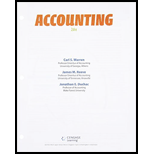
Explain the main advantages of:
- (a) Proprietorship.
- (b)
Partnership . - (c) Limited Liability Company.
Explanation of Solution
Proprietorships: Proprietorship is a form of organization, which is owned, and controlled by an individual called the proprietor. The owners’ liability is unlimited. The most common proprietors are lawyers, physician, a small business owner and more.
Partnership: It is that form of organization which is owned and managed by two or more persons who invest and share the
Limited Liability Company: It is that form of organization which is formed as a legal entity with state charter that provides limited liability to the owners. It has a common seal.
(a) The main advantages of Proprietorships are:
Easy of formation: It is easy for forming this type of entity.
Non-taxable entity: This entity is not taxed for federal income tax purposes.
(b) The main advantages of Partnership are:
Expertise can be pooled: Expertise from different field can be pooled in as required for a business under partnership.
Non-taxable entity: This entity is not taxed for federal income tax purposes.
(c) The main advantages of Limited Liability Company are:
Legal entity: A limited liability company has a legal entity separate from its owners. It can transact business and represent the company of its own.
Expanded access to Capital: A limited liability company can pool a big capital required for the business through issuing shares to the public.
Separation of ownership and management: The management of the company is taken over by the professionals, separate from the owners.
Sustainability: The existence of the limited liability company continues for a long period of time and does not wind up with the death of any shareholders unlike partnership.
Easy transferability of ownership: In limited liability company, the ownership is transferred easily through buying and selling of shares in stock exchange.
Want to see more full solutions like this?
Chapter 12 Solutions
Bundle: Accounting, Loose-Leaf Version, 26th + CengageNOWv2, 2 term Printed Access Card
- Sequoia Resorts pays $780,000 plus $17,500 in closing costs to buy out a competitor. The real estate consists of land appraised at $95,000, a building appraised at $342,000, and recreational equipment appraised at $398,000. Compute the cost that should be allocated to the building.arrow_forwardI need help with this solution and general accounting questionarrow_forwardCozy Retreats currently sells 420 Standard hot tubs, 580 Luxury hot tubs, and 190 Premium model hot tubs each year. The firm is considering adding a Comfort model hot tub and expects that, if it does, it can sell 340 of them. However, if the new hot tub is added, standard sales are expected to decline to 290 units while Luxury sales are expected to decline to 310. The sales of the Premium model will not be affected. Standard hot tubs sell for an average of $8,900 each. Luxury hot tubs are priced at $14,500 and the Premium model sells for $22,000 each. The new Comfort model will sell for $12,300. What is the value of erosion?arrow_forward
- Salma Production uses direct labor cost as the allocation base for applying MOH to WIP. The budgeted direct labor cost for the year was $850,000. The budgeted manufacturing overhead was $722,500. The actual direct labor cost for the year was $910,000. The actual manufacturing overhead was $745,000. A. What was Salma's predetermined manufacturing overhead rate per direct labor dollars? B. How much MOH was applied to WIP during the year?arrow_forwardHello tutor solve this question and accountingarrow_forwardThe total factory overhead for Leicester Manufacturing is budgeted for the year at $756,000. Leicester manufactures two product lines: standard lamps and premium lamps. These products each require 4 direct labor hours to manufacture. Each product is budgeted for 8,000 units of production for the year. Determine the factory overhead allocated per unit for premium lamps using the single plantwide factory overhead rate.arrow_forward
- I need help with this solution and accounting questionarrow_forwardhttps://investor.exxonmobil.com/sec-filings/annual-reports/content/0000034088-25-000010/0000034088-25-000010.pdf Use link to help me answer my question please in picturearrow_forwardHello tutor solve this question and accountingarrow_forward
- Can you solve this general accounting question with accurate accounting calculations?arrow_forwardPlease provide the solution to this general accounting question with accurate financial calculations.arrow_forwardI need help with this general accounting problem using proper accounting guidelines.arrow_forward
 EBK CONTEMPORARY FINANCIAL MANAGEMENTFinanceISBN:9781337514835Author:MOYERPublisher:CENGAGE LEARNING - CONSIGNMENT
EBK CONTEMPORARY FINANCIAL MANAGEMENTFinanceISBN:9781337514835Author:MOYERPublisher:CENGAGE LEARNING - CONSIGNMENT


